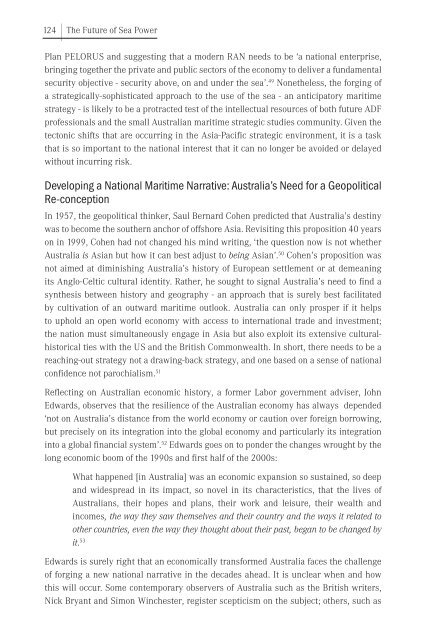THE FUTURE OF SEA POWER
SPC2015_Proceedings
SPC2015_Proceedings
Create successful ePaper yourself
Turn your PDF publications into a flip-book with our unique Google optimized e-Paper software.
124 |<br />
The Future of Sea Power<br />
Plan PELORUS and suggesting that a modern RAN needs to be ‘a national enterprise,<br />
bringing together the private and public sectors of the economy to deliver a fundamental<br />
security objective - security above, on and under the sea’. 49 Nonetheless, the forging of<br />
a strategically-sophisticated approach to the use of the sea - an anticipatory maritime<br />
strategy - is likely to be a protracted test of the intellectual resources of both future ADF<br />
professionals and the small Australian maritime strategic studies community. Given the<br />
tectonic shifts that are occurring in the Asia-Pacific strategic environment, it is a task<br />
that is so important to the national interest that it can no longer be avoided or delayed<br />
without incurring risk.<br />
Developing a National Maritime Narrative: Australia’s Need for a Geopolitical<br />
Re-conception<br />
In 1957, the geopolitical thinker, Saul Bernard Cohen predicted that Australia’s destiny<br />
was to become the southern anchor of offshore Asia. Revisiting this proposition 40 years<br />
on in 1999, Cohen had not changed his mind writing, ‘the question now is not whether<br />
Australia is Asian but how it can best adjust to being Asian’. 50 Cohen’s proposition was<br />
not aimed at diminishing Australia’s history of European settlement or at demeaning<br />
its Anglo-Celtic cultural identity. Rather, he sought to signal Australia’s need to find a<br />
synthesis between history and geography - an approach that is surely best facilitated<br />
by cultivation of an outward maritime outlook. Australia can only prosper if it helps<br />
to uphold an open world economy with access to international trade and investment;<br />
the nation must simultaneously engage in Asia but also exploit its extensive culturalhistorical<br />
ties with the US and the British Commonwealth. In short, there needs to be a<br />
reaching-out strategy not a drawing-back strategy, and one based on a sense of national<br />
confidence not parochialism. 51<br />
Reflecting on Australian economic history, a former Labor government adviser, John<br />
Edwards, observes that the resilience of the Australian economy has always depended<br />
‘not on Australia’s distance from the world economy or caution over foreign borrowing,<br />
but precisely on its integration into the global economy and particularly its integration<br />
into a global financial system’. 52 Edwards goes on to ponder the changes wrought by the<br />
long economic boom of the 1990s and first half of the 2000s:<br />
What happened [in Australia] was an economic expansion so sustained, so deep<br />
and widespread in its impact, so novel in its characteristics, that the lives of<br />
Australians, their hopes and plans, their work and leisure, their wealth and<br />
incomes, the way they saw themselves and their country and the ways it related to<br />
other countries, even the way they thought about their past, began to be changed by<br />
it. 53<br />
Edwards is surely right that an economically transformed Australia faces the challenge<br />
of forging a new national narrative in the decades ahead. It is unclear when and how<br />
this will occur. Some contemporary observers of Australia such as the British writers,<br />
Nick Bryant and Simon Winchester, register scepticism on the subject; others, such as


